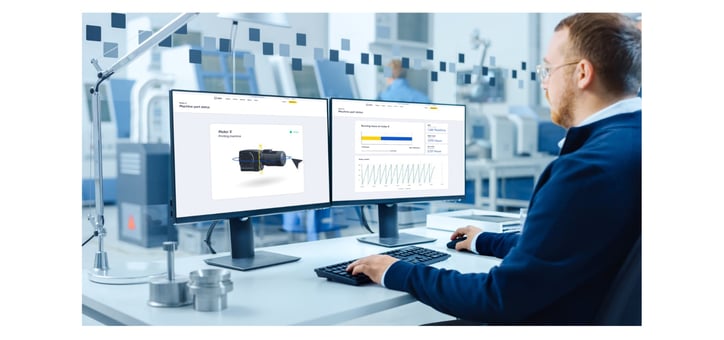While digital transformation is well underway in the manufacturing industry and across all machine builders, there are still a lot of questions around this topic. What’s in it for me? What technologies can help me to transform? And what’s the next step to take?
According to McKinsey, digital transformation is 'an effort to enable existing business models by integrating advanced technologies'. The bottom line is that new technologies can be integrated into existing business models, changing the way you work and deliver your product or service. Actually, you’ve already started your digital transformation if you’re using connectivity or data to improve business outcomes. It’s now time to stay relevant and add value for your customers.
Create a win-win situation for both your own business and your customers. Digital transformation gives you a competitive advantage, creates new business opportunities, and enhances your efficiency. A big opportunity lies in providing excellent service to your customers during the entire lifecycle of your machines.
In our E-book 'Service opportunities for OEMs that boost revenue and meet customer demands' we share some examples of business models resulting in complementary recurring revenue.
Shift from selling technology to selling services
OEM machine builders have been focused on selling technology, such as Industrial IoT, to their customers by telling them about the big advantages it offers both parties. Not surprising, because thinking from a technical perspective is in their DNA.
But, your customers are not specifically interested in technology, they just demand the best possible service from you when they experience problems with their machines that impact their production. By implementing service focused business models, you can deliver excellent service, and increase customer satisfaction and cash flow at the same time.
Digital transformation is essential to offer the highest level of support to your customers. Industrial IoT can facilitate a huge digital transformation and is the enabler of these service focused business models. A simple start is to standardise and optimise remote service.

Service model: field service optimisation
We all know unplanned maintenance is inefficient and can cause long downtime. It’s particularly troublesome during the warranty period. You would like to get through without any major issues like financial penalties resulting in hardly earning any money.
But no worries, this is easily tackled by standardising remote access in your machines. Remote access enables you to remotely troubleshoot from any location and prevent financial penalties. Among our customers we see that on average over 60% of issues are solved remotely. This means you cut on travel expenses and customer satisfaction will increase due to high response times and decreased downtime.
By turning unplanned downtime into planned downtime with remote access you ensure excellent service during the entire lifecycle of your machines. After the warranty period is completed, you can provide a report to your customer with an overview of all downtime, failures and root causes of the past period. This could be the starting point of turning the remote service provided during warranty into a paid service after warranty.
The field service optimisation business model brings several benefits for both customers and machine builders:
Benefits for customers
- Machine issues are quickly solved
- Decrease in downtime
- Reduced costs
- Insights in failures and causes
|
Benefits for machine builders
- Increased efficiency and flexibility
- Cost savings and quick ROI
- Successful completion of the warranty phase
- Time left for other projects or activities
|
Service models to improve your service and increase revenue
After you start optimising your field service efficiency, there are a lot more options to leverage excellent service to your customers. We’ve explained them in our E-book 'Service opportunities for OEMs that boost revenue and meet customer demands'. Here’s a quick overview:
Remote access as a service
Sell an SLA in which you guarantee the same level of service as during the warranty period using remote access.
Wear and tear parts monitoring
Decrease downtime by monitoring wear and tear parts, and prevent lost production time by replacing worn parts just-in-time.
Predict critical component breakdown
Predict breakdown of critical machine parts to prevent costly machine standstill by continuously monitoring their condition.
Consumables as a service
Supply your own consumables or sell machines that produce optimised consumables for your machines to unburden your customers.

What do these service models offer you in terms of revenue potentials?
When you implement one of the above-mentioned service models, you are well on your way with your digital transformation. Additionally, they don’t require a huge investment while it does quickly result in a return on investment (ROI). On top, you have a chance of recurring revenue to stabilise your cash flow.
By implementing the earlier discussed service model Field service optimisation you can already achieve return on investment (ROI) after the first saved service trip with IXON Cloud, because on average, a service trip costs 5 times the price of an IXrouter.
Discover what else you can get out of these business opportunities, before missing the boat. In our E-book: 'Service opportunities for OEMs that boost revenue and meet customer demands' you will find a more detailed explanation of these service models in the form of use cases, including business cases.

